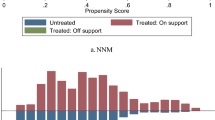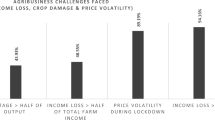Abstract
Agrarian distress is a global issue and is directly linked to poverty and hunger in developing countries. In India, agrarian distress has been manifested in the form of farmers’ suicide for the past 20 years. Agrarian distress in the farm household is resulting in deteriorated living standards, challenges in getting a quality education, forced migration, unmanageable health expenses, and poor nutrition level. In this regard, financial analysis is an effective method to identify the severity of the agrarian distress in the farm households (FHH). In this study, a financial analysis of 150 FHHs from Yavatmal district (being India’s most agrarian distressed area) has been conducted for three consecutive years from 2016–17, 2017–18, and 2018–19. After preparing financial statements and computing financial performance measures, FHHs have been categorized into five groups (i) FHHs not earning profit from the farm, (ii) FHHs not able to save money at the end of the year, (iii) FHHs putting their asset in risk, (iv) FHHs not able to repay the loan, and (v) FHHs not able to earn sufficient from farm to fulfill their HH expenditure. It has been observed that 22%, 16%, and 14% of the sampled FHHs, respectively in the year 2016–17, 2017–18, and 2018–19 earned sufficient from their farm to fulfill their domestic expenditure (category v). Thus, it was found that year on year the percentage of farmers able to meet their household expenditure was decreasing which could be of help to policymakers in deciding the remedies to improve the financial status of the distressed FHHs.
Access this chapter
Tax calculation will be finalised at checkout
Purchases are for personal use only
Similar content being viewed by others
References
Alan M, Cole E, Craig D, Michael B (2001) Measuring and analysing farm financial performance. Centre for Food and Agricultural Business Purdue University
Behere PB, Bhise MC (2009) Farmers’ Suicide: across culture. Indian J Psychiatry 51(4):242–243
Census of India (2011) District Census Handbook Yavatmal. Directorate of Census Operations, Maharashtra
Centre for Micro Finance (2006) Insight into the cash flow of rural households. Centre for micro finance, Jaipur
Das L (2015) Agrarian crisis in India: causes, consequences and remedies. Int J English Lang Hum III(X):615–631
Dhas C (2009) Agriculture crisis in India: the root cause and consequences. Munich Personal RePEc Archive
Dongare (2013) Ground Water Information Yavatmal District Maharashtra. Government of India, Ministry of Water Resources, Central Ground Water Board, Central Region, Nagpur
Edwards W (2017) Farm financial statements. IOWA State University
Financial Guidelines for Agriculture Producers (2011) Farm Financial Standards Councils, USA
Goffin (2014) Farmers’ mental health: a review of the literature. Accident Compensation Corporation Policy Team, New Zealand
Honkalaskar VH, Kedare SB, Bagade N (2018) Understanding agrarian crisis: a participatory and qualitative systemic analysis. J Agric Stud 6(1):261–298
IGIDR (2006) Suicide of farmers in Maharashtra. Indira Gandhi Institute of Development Research, Mumbai
Jodhka SS (2012) Agrarian changes in the times of (neo-liberal) ‘crises’. Econ Polit Wkly XLVII(26 & 27):5–13
Kher D (2015) Farmer suicides: a global phenomenon, 6 May 2015. Available: http://pragati.nationalinterest.in/2015/05/farmer-suicides-a-global-phenomena/. Accessed 25 Nov 2016
Merriott D (2016) Factors associated with the farmer suicide. J Epidemiol Glob Health
Mishra S (2008) Risks, farmers’ suicides and agrarian crisis in India: is there a way out? Indian J Agric Econ 63(1):38–54
Mishra CW, Williams R (2009) Factors affecting financial performance of new and beginning farmers. Agric Finance Rev 69(2):160–179
Neuman WL (2013) Social research methods. Dorling Kindersley India, New Delhi
NSS (2011) Level and pattern of consumer expenditure. National Sample survey office, NSO, GoI, New Delhi
NSS (2012) Household consumer expenditure across socio-economics group, NSS 66th round. National Sample Survey Office, Government of India, New Delhi
NSS (2013) Public distribution system and other sources of household consumption. NSSO, MSPI, GOI, New Delhi
Patnaik U (2003) Global capitalism, deflation and agrarian crisis in developing countries. J Agrar Change 3(1 and 2):33–66
Plastina (2017) Financial Performance measure for IOWA farm. IOWA State University
Ploeg JDVD (2010) The food crisis, industrialized farming and the imperial regime. J Agrar Chang 10(1):98–106
Pujari, Biru BK (2007) Jansunvai on present agrarian crisis a report. Gene Campaign
Qaim M (2010) Benefit of genetically modified crops for the poor: household income, nutrition, and health. New Biotechnol 27(5):552–557
Rotan B (2005) Analysis of financial statements: local farm supply, market co-ops, 2003. United States Department of Agriculture
Sahay GR (2010) Globalization, liberalization and agrarian distress: a study of suicides among farmers in India. Tata Institute of Social Science, Mumbai
Sarkunde M (2014) Yavatmal: District of Farmers’ Suicide, 9 Mar 2014. Available: http://www.boloji.com/index.cfm?md=Content&sd=Articles&ArticleID=15601. Accessed 9 Jan 2017
Selvavinayagam (1991) Financial analysis in agriculture project preparation. Food and Agriculture Organization of United Nation, Rome
Severini S, Tantari A, Di Tommaso G (2016) The instability of farm income. Empirical evidences on aggregation bias and heterogeneity among farm groups. Bio-Based Appl Econ 5(1):63–81
Sharma RS (2012) Ratio analysis in farm management. Int J Recent Res Rev 1:47–50
Siddiqui K (2015) Agrarian Crisis and Transformation in India. Econ Polit Econ 2(1):3–22
Smith P, Martino D, Cai Z, Gwary D, Janzen H, Kumar P, McCarl B, Ogle S, O'Mara F, Rice C, Scholes B, Sirotenko O (2007) Agriculture. In: Metz B, Davidson OR, Bosch PR, Dave R, Meyer LA (eds) Climate change 2007: Mitigation. Contribution of working group III to the fourth assessment report of the intergovernmental panel on climate change. Cambridge University Press, Cambridge, United Kingdom and New York, NY, USA
Surjit V (2017) The evolution of farm income statistics in India: a review. Review Agrar Stud 7(2):39–61
TISS (2005) Causes of farmers’ suicides in Maharashtra: an enquiry. Tata Institute of Social Science, Mumbai
World Bank (2016) The World Bank, The World Bank Group, 2016. Available: http://data.worldbank.org/indicator/SL.AGR.EMPL.ZS?end=2010&name_desc=false&start=1994&view=chart. Accessed 2020
Yavatmal CO (2012) Yavatmal District, 29 Oct 2012. Available: http://yavatmal.nic.in/. Accessed Jan 2017
Acknowledgements
The authors would like to thank the partner NGO ‘Deendayal Bahu-Uddeshiya Prasarak Mandal’ for providing a platform to interact with farmers in Yavatmal, India. The authors are thankful for the 150 farm households from Indiragram, Malkhed, and Pathari who participated in the survey activity and gave a glimpse of their beautiful lives.
Author information
Authors and Affiliations
Corresponding author
Editor information
Editors and Affiliations
Rights and permissions
Copyright information
© 2023 The Author(s), under exclusive license to Springer Nature Singapore Pte Ltd.
About this paper
Cite this paper
Bagade, N., Rao, B., Kedare, S.B., Vekhande, S., Honkalaskar, V. (2023). Farm Household Accounting System for Financial Analysis in Distressed Areas of Rural India. In: Chigullapalli, S., Susha Lekshmi, S.U., Deshpande, A.P. (eds) Rural Technology Development and Delivery. Design Science and Innovation. Springer, Singapore. https://doi.org/10.1007/978-981-19-2312-8_4
Download citation
DOI: https://doi.org/10.1007/978-981-19-2312-8_4
Published:
Publisher Name: Springer, Singapore
Print ISBN: 978-981-19-2311-1
Online ISBN: 978-981-19-2312-8
eBook Packages: EngineeringEngineering (R0)




